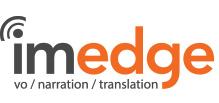How do you determine your rates?
There are many different methods when it comes to structuring a rate card. The important thing is to be fair while remaining competitive. Our fees are based on length of time of finished audio. This can be established prior to recording by the word count of the project. Contact us with your project for a quote. With your script we calculate how long the production will be in its completed state.
What does your quoted rate include?
Once we determine from your script how long the final audio will be, your rate for a cold voice recording includes:
- Studio time
- Post production: editing /mastering
- Talent fee
- Digital delivery
- Full buyout
Additional costs apply for extra voice talent, music production, translation/proofing services, etc.
What’s a full buyout?
A full buyout means you own that recording and can play it wherever and whenever you choose without any residual or royalty fees. It’s a one-time fee.
What is “cold voice”?
This is a recording that simply has one or more voices—without additional production elements such as music or sound effects.
What is e-learning?
Electronic Learning, or e-learning, is education via the Internet, network, or stand-alone computer—a network-enabled transfer of skills and knowledge. Another term for e-learning is ‘computer based training’. It is the use of electronic applications and processes to learn, such as Web-based learning, computer-based learning, virtual classrooms, and digital collaboration. Content is delivered via the Internet, intranet/extranet, audio or video tape, satellite TV, and CD-ROM.
What’s a Webinar?
Webinar is a web-driven workshop. It is “asynchronous,” meaning that it does not take place in real time. Instead, you log in to participate when you have the time. Webinars are focused on the organizational communication profession: public relations, employee communications, media relations, investor relations, community relations, and other communication disciplines that target key organizational audiences.
What’s a wave(.wav) file?
The WAV sound file format, also known as ‘wave’, ‘movie sound file’ and ‘Windows sound format’, is a video file used to save and record short sound clips. They are normally not used for recording and saving long pieces of music or sound. Reason? WAV files are rarely compressed, so the file size is massive…much too large to download/trade on the internet everyday. MP3 files (mpeg layer 3) are the standard sound file type for that type of application.
What’s an .aiff file?
Audio Interchange File Format (AIFF). AIFF files are often used to store digital audio data on Apple computers as opposed to the .wav format for PCs.
What’s an mp3?
The MPEG layer 3 audio codec significantly compresses the original audio source with very little loss in sound quality. The compression up to 12:1 produces very little degradation. Tighter compression can be achieved, but it will result in sound degradation.
To give you an idea about data filtering, 60 seconds of CD-quality music is equal to about 10 MB of data. 60 seconds of MP3 music at 128 KB/second is equal to about 1 MB. The bit rate, simplified, describes how many storage ‘bits’ one second of audio data will use on disc, whether on a hard drive or a removable CD-R.
What is IVR?
Interactive Voice Response—the blanket term for automated call handling systems where the user interacts with a computer controlled voice signal (either recorded real speech or computer generated). The interaction can be through the use of a touch tone telephone or through speech recognition.
What is vocal timbre?
Timbre is a general term for the distinguishable characteristics of a tone. Sounds may be generally characterized by pitch, loudness, and quality. Sound “quality” or “timbre” describes those characteristics of sound which enable our ear to distinguish sounds with the same pitch and loudness.
What is cadence?
A rhythmic pattern of movement, as in music or poetry… a beat, rhythm or lilt in the speech pattern.
What is a voice over?
The voice of an unseen narrator speaking (as in a motion picture or television commercial) The abbreviation “VO” is commonly used within the industry.
What is FTP?
File Transfer Protocol is a way of transferring files over the Internet from one computer to another. FTP is a convenient and quick way to access and download your finished audio. This is much better than sending large files as e-mail attachments which potentially get blocked because of their size.
What is a phone patch?
A phone patch is a small box that connects the recording studio’s telephone line and mixing board. It allows the client to listen in to a recording session in real time using their telephone/speaker without disturbance or noise from their end winding up in the finished audio. The voice artist can also hear any direction from the client through the headphones.
What is ISDN?
Integrated Services Digital Network is a service offered by most telephone carriers for the transmission of voice and data instead of analog signals, allowing data to be transmitted at a much faster rate than with a traditional modem.
What’s a demo?
“Demo”, short for “demonstration”— and that’s exactly what you receive. A demo is a sample of how the voice talent sounds or how your specific script will read. It is usually just a small portion of a bigger voice over to give you an idea of how it will fit in to your production.
What are “wild lines”?
Wild lines are sometimes requested of voice talent when the client is looking for variations on a word or phrase. The talent will be asked to provide several wild lines of existing script. The client can then listen back following the recording session to determine which one works best for the tone or feel of the script.

